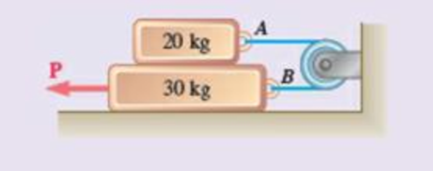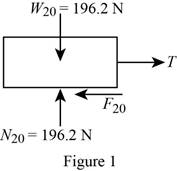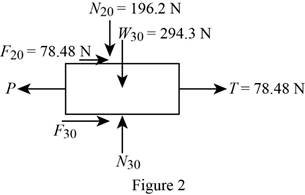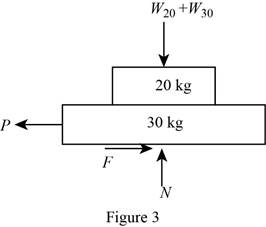
8.134 and 8.135 The coefficients of friction are μS = 0.40 and μk = 0.30 between all surfaces of contact. Determine the smallest force P required to start the 30-kg block moving if cable AB (a) is attached as shown, (b) is removed.

(a)
Find the smallest value of P required to start moving the 30 kg block if the cable AB is attached.
Answer to Problem 8.134RP
The smallest force P required to move the 30-kg block is
Explanation of Solution
Given information:
The coefficient of static friction is
The coefficient of kinetic friction is
Calculation:
Consider the acceleration due to gravity as
Find the weight of the 20-kg mass block as follows;
Find the weight of the 30-kg mass block as follows;
Show the free-body diagram of the 20-kg mass block as in Figure 1.

Find the normal force
Find the friction force
Substitute 0.40 for
Find the tension in the cable AB (T) by resolving the horizontal component of forces.
Show the free-body diagram of the 30-kg mass block as in Figure 2.

Find the normal force
Find the friction force
Substitute 0.40 for
Find the force P by resolving the horizontal component of forces.
Therefore, the smallest force P required to move the 30-kg block is
(b)
Find the smallest value of P required to start moving the 30 kg block if the cable is removed.
Answer to Problem 8.134RP
The smallest force P required to move the 30-kg block is
Explanation of Solution
Given information:
The coefficient of static friction is
The coefficient of kinetic friction is
Calculation:
Consider the acceleration due to gravity as
Find the weight of the 20-kg mass block as follows;
Find the weight of the 30-kg mass block as follows;
Show the free-body diagram of the block assembly as in Figure 3.

Find the normal force (N) by resolving the vertical component of forces.
Find the friction force (F) using the relation.
Substitute 0.40 for
Find the force P by resolving the horizontal component of forces.
Therefore, the smallest force P required to move the 30-kg block is
Want to see more full solutions like this?
Chapter 8 Solutions
Vector Mechanics for Engineers: Statics and Dynamics
- practise questionarrow_forwardCan you provide steps and an explaination on how the height value to calculate the Pressure at point B is (-5-3.5) and the solution is 86.4kPa.arrow_forwardPROBLEM 3.46 The solid cylindrical rod BC of length L = 600 mm is attached to the rigid lever AB of length a = 380 mm and to the support at C. When a 500 N force P is applied at A, design specifications require that the displacement of A not exceed 25 mm when a 500 N force P is applied at A For the material indicated determine the required diameter of the rod. Aluminium: Tall = 65 MPa, G = 27 GPa. Aarrow_forward
- Find the equivalent mass of the rocker arm assembly with respect to the x coordinate. k₁ mi m2 k₁arrow_forward2. Figure below shows a U-tube manometer open at both ends and containing a column of liquid mercury of length l and specific weight y. Considering a small displacement x of the manometer meniscus from its equilibrium position (or datum), determine the equivalent spring constant associated with the restoring force. Datum Area, Aarrow_forward1. The consequences of a head-on collision of two automobiles can be studied by considering the impact of the automobile on a barrier, as shown in figure below. Construct a mathematical model (i.e., draw the diagram) by considering the masses of the automobile body, engine, transmission, and suspension and the elasticity of the bumpers, radiator, sheet metal body, driveline, and engine mounts.arrow_forward
- 3.) 15.40 – Collar B moves up at constant velocity vB = 1.5 m/s. Rod AB has length = 1.2 m. The incline is at angle = 25°. Compute an expression for the angular velocity of rod AB, ė and the velocity of end A of the rod (✓✓) as a function of v₂,1,0,0. Then compute numerical answers for ȧ & y_ with 0 = 50°.arrow_forward2.) 15.12 The assembly shown consists of the straight rod ABC which passes through and is welded to the grectangular plate DEFH. The assembly rotates about the axis AC with a constant angular velocity of 9 rad/s. Knowing that the motion when viewed from C is counterclockwise, determine the velocity and acceleration of corner F.arrow_forward500 Q3: The attachment shown in Fig.3 is made of 1040 HR. The static force is 30 kN. Specify the weldment (give the pattern, electrode number, type of weld, length of weld, and leg size). Fig. 3 All dimension in mm 30 kN 100 (10 Marks)arrow_forward
- (read image) (answer given)arrow_forwardA cylinder and a disk are used as pulleys, as shown in the figure. Using the data given in the figure, if a body of mass m = 3 kg is released from rest after falling a height h 1.5 m, find: a) The velocity of the body. b) The angular velocity of the disk. c) The number of revolutions the cylinder has made. T₁ F Rd = 0.2 m md = 2 kg T T₂1 Rc = 0.4 m mc = 5 kg ☐ m = 3 kgarrow_forward(read image) (answer given)arrow_forward
 International Edition---engineering Mechanics: St...Mechanical EngineeringISBN:9781305501607Author:Andrew Pytel And Jaan KiusalaasPublisher:CENGAGE L
International Edition---engineering Mechanics: St...Mechanical EngineeringISBN:9781305501607Author:Andrew Pytel And Jaan KiusalaasPublisher:CENGAGE L
